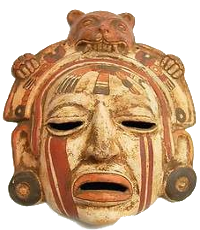Children of the mountain
In 1999 a horrible discovery was made by a team of researchers near the summit of Llullaillaco, a 6,700 meter high volcano on the border between Argentina and Chile. Three small children were found dead in a pit. Yet the researchers knew right away that these were not recent casualties. The children of the mountain were the sacrificial victims of an Inca ceremony conducted some five hundred years ago. Subsequent analysis showed that the three – two girls, 15 and 6 years old, and a boy of 7 – had been fattened up and drugged with alcohol and coca before they died. They had most likely fallen asleep in their tomb and then frozen to death. Their mummified bodies have been extraordinarily well preserved in the cold and very dry environment. The internal organs are intact, individual hairs are preserved, and they look more or less as they must have looked when they died. In fact, they could almost be alive.
Child sacrifice was an important part of the religion of the Incas. It was a way to commemorate important events, such as the death of a Sapa Inca, or they were offerings to the gods in times of famine or war. It was considered a great honor to die as a sacrifice, and only the most physically perfect children were selected, often of noble families or local rulers. First they were taken to Cusco where they underwent various purification rituals, and from there they were dispatched to mountaintops throughout the empire. The 15 year old girl was most likely a “Sun Virgin,” chosen at the age of ten to live with other girls and women who would become royal wives, priestesses and sacrifices. According to Inca beliefs, children who are sacrificed do not actually die but watch instead over the land from their mountaintop perches.
Today a museum has been built for the children. At the Museum of High Altitude Archaeology in Salta, Argentina, they have recreated the exact conditions of the mountain where they were found. Yet some indigenous groups object to what they regard as “their children” being put on display in this fashion. Other indigenous groups strongly approve of any research that can help spread knowledge of their ancestors. It is estimated that there are some 40 similar burial sites in the region, but for now at least no more mummies will be removed from the mountains.
External links:
- “Radiologic Evaluation of the Llullaillaco Mummies,” American Journal of Roentgenology, 2003
- Andes Handbook, “Volcán Llullaillaco”
- Johan Reinhard, Ice maiden: inca mummies, mountain gods, and sacred sites in the andes
- Live Science, “Inca child mummies”
- Museum of High Altitude Archaeology
- Radiolab, “An icecold case”
- Science, “‘Llullaillaco Maiden’ May Have Been Drugged Before Sacrificed”
- The Guardian, “Child mummies ‘fattened up’ before Inca sacrifice “

